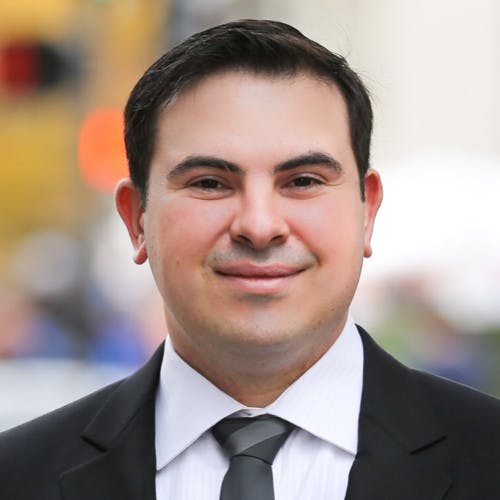Season 10 - Episode 2
The Product / Marketing Connection by Instacart VP of Brand & Marketing
Product people have to understand many parts of a business. Laura Jones, VP of Brand & Marketing at Instacart, tells us how Product and Marketing can work together—so that you’re not only building awesome products, but you’re also effectively communicating about them with your customers.

“I can’t wait to break down the concept of marketing. The brand, the demand gen, the product marketing, and the intersection between marketing and product. Why didn’t you say more about your own journey and how you were able to secure incredible jobs at Google, Uber, and Instacart?”
Reflecting on the journey. I think I can boil it down to having been somebody from a young age who was right brained and left brained equally, kind of interested in analytical and creative pursuits.
And I think that the story of my career has been very much trying to find roles where I can flex both sides of that muscle. And that manifests academically in majoring in economics, but spending a lot of time doing studio art, working early in my career as a strategy consultant, and going to do painting classes at night.
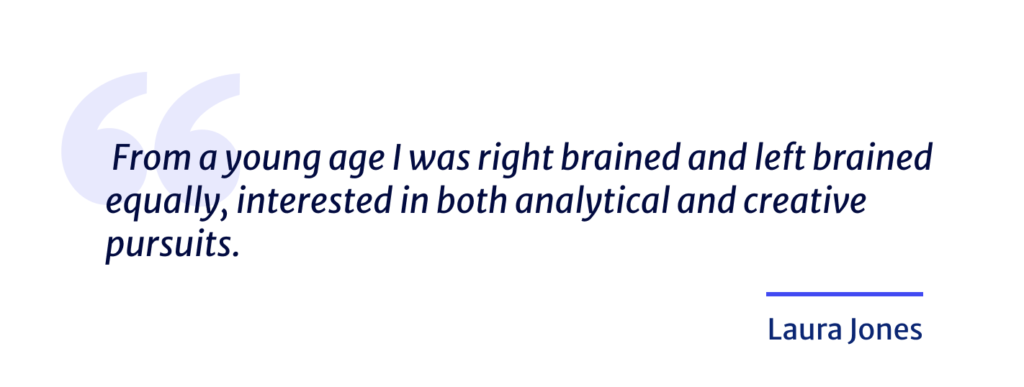
It all came together for me when I went to business school at Stanford and spent really the majority of my time there at the d.school and, and really found a way to integrate that creative and analytical approach into a holistic way of thinking about problem solving. And that led me into a career first in product marketing, and now as a marketing leader at Instacart.
“Your title says is VP of Brand and Marketing. What is the distinction there?”
To me, brand is a subset of marketing but not limited to just the marketing discipline. When I think about building a brand, I think about the aspect of upper funnel marketing plus the manifestation of that brand across the entire customer experience. So really thinking about not just that kind of upper funnel mass media campaign, but then what happens when someone hits the product, how is the brand expressed in the product? How do we develop a relationship with that customer, create community with them, and eventually turn them into an advocate?
I think the brand piece really touches marketing, but spans a bit beyond it. And that’s manifest in the work where the creative team is developing core aspects of our product experience from a design standpoint and really helping to bring to life the brand in various kind of touchpoints that go beyond kind of the typical marketing channels as you may think of them.
And then on the flip side I think about marketing as that full funnel experience. So really not just the top of funnel brand piece, but then also our performance marketing and our product marketing and CRM organizations. So really thinking about the full experience of getting a customer to be aware, getting them activated, getting them engaged and getting them retained. To me they’re related disciplines, but a Venn diagram where they overlap, but are not exactly the same thing.
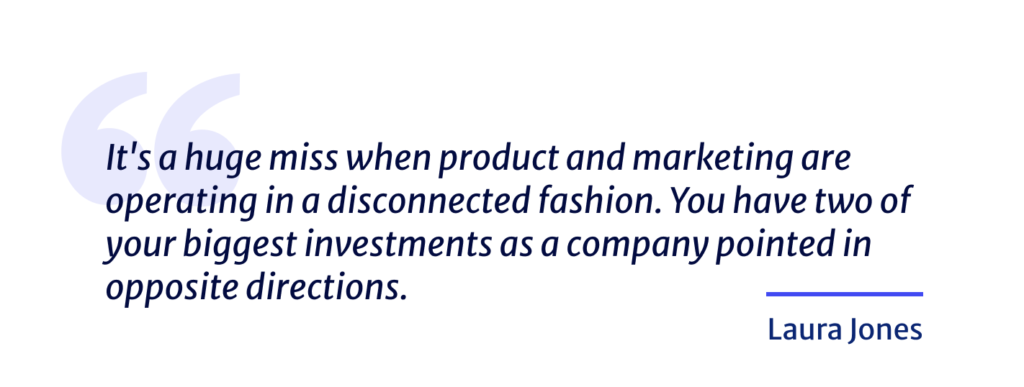
“You mentioned product marketing multiple times, and I’m glad to hear that because it’s growing fast. It’s a very important function that can go either way. Sometimes we will have it under marketing, sometimes we will have it under product. How do you think about product marketing, and how does it connect with the product team?”
It’s a really great question. My journey at Uber was exactly the one you described, where initially product marketing sat in Product. And I came over to Uber with an incredible Product Leader I’d worked with at Google. And initially we built out product marketing in the product org and our goal was really to drive product adoption.
Then once Uber reached us certain state of maturity as a company and hired its first CMO, we brought together all of the marketers into a single marketing org, then moved from thinking about each product in a silo to really thinking about their place in the customer journey and really making sure that we were serving as that connective tissue between that upper funnel messaging and what the product team was building. So that the story of the company was a holistic one.
Read next: The Difference: Product Manager vs Product Marketing Manager
I always think it’s a huge miss when product and marketing are operating in a disconnected fashion. You have two of your biggest investments as a company pointed in opposite directions. And those two investments are your tech team, which is usually a large portion of your head count, and a significant portion of your resources. They may be pointed at one roadmap, but then you have your, your brand media or your media spend pointed in a different direction. That can end up with, I think really disconnected customer experiences, or less effective marketing. Because you’re not really focused in telling a single story across the entire company and to your customer and really being clear what you stand for.
I think of product marketing as that connective tissue to say, who are we building for? What should we be building? And then how do we make people aware of that? And how do we take that message, put it into the biggest loudest messages that the company is distributing via the marketing channels. And I think that’s the real value of product marketing.
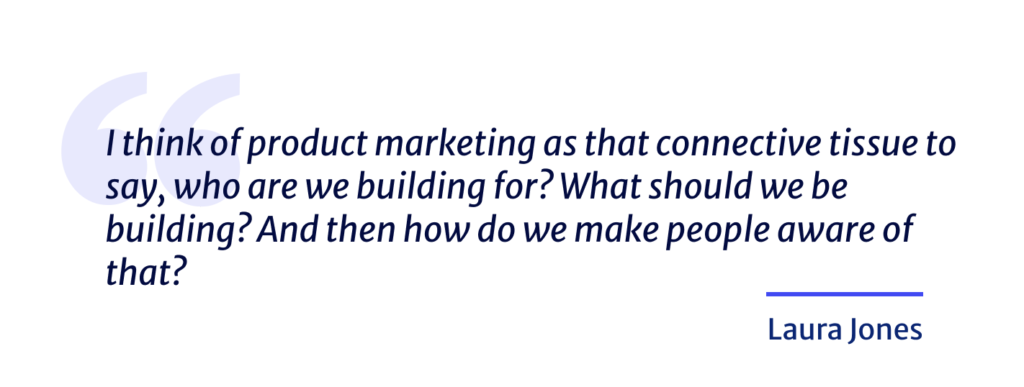
“It’s happening not only in super high tech companies in Silicon Valley, or New York, or other tech hubs. It’s really a need across the board. Now with product, those two functions need to be elevated at the same level as demand gen. This is not just about just churning leads and then bringing new ones.”
Yeah, absolutely. When I offer career advice to younger marketers, I really think of those as the three legs of the stool.
You wanna have somebody that really develops that kind of core / growth / demand gen muscle, and really understands how to use channels to grow business and bring customers in.
You wanna have somebody who really understands brand and how to tell a compelling story and create a cohesive experience.
And then you really want somebody to understand product marketing and how to articulate a clear value proposition to an audience and thread that across the entire experience.
“Can you give us a quick overview of Instacart?”
Yeah, a hundred percent. Instacart is groceries on demand. And really our heritage as a company has been being the market leader in taking that on demand eCommerce model and bringing it to one of the largest purchase categories out there, which is grocery.
Now as we evolve as a company, we’re starting to diversify into other verticals. So looking at convenience, looking at non grocery retailers, and starting to now deliver from places like Sephora and Best Buy. But I think we’re most famous for being grocery delivery.
And it’s certainly a story that is deeply interwoven with our experience over the past two years as a global population with the pandemic, really seeing huge growth in the category and really taking this company from an earlier, more niche product to something that now is on the path to really being a mass beloved product.
Check out: What Is a Minimum Lovable Product?
“Going back to your own role there as a VP of Brand and Marketing, if I were zoom into your calendar, where do you spend most of your energy on a week by week basis?”
It’s evolved. I’ve been at Instacart for six months, coming off of six years at Uber. When I started the team, I was running was under 30 people. And then through the evolution of the org teams coming together, we’re now almost 120 across all of marketing.
I would say that the process of scaling the team has been different on a monthly and even a weekly basis, just kind of given what problem we need to tackle. So early on, I invested a disproportionate amount of time in setting the vision and strategy and working closely with our market intelligence team, working with the research team, really understanding what are the market dynamics, where is the opportunity from a TAM standpoint?
What’s the business case? Why do we need marketing? And then once we’ve clearly outlined the jobs to be done for marketing at the company then thought about, okay, now what should we do? How should we bring ourselves to the world? And spent a bunch of time articulating our brand vision, our brand strategy.
So that was really Chapter One. What is our vision? What is our strategy? And that really had two impacts. One was giving the team kind of a rally cry, helping us feel a sense of identity and purpose and understanding what our goals are and how they ladder up to something bigger. And then building credibility with leadership. So saying, here’s why we exist. Here’s why we need to exist as a team. Here’s what we’re going to deliver for the business in terms of revenue and growth over the next three years. And here’s the level of investment needed to support that.
And then Chapter Two was capability building. Once we had our mandate, once we had our head count and budget going through and saying, what are the capabilities that we need to build in order to run a world class marketing organization? Everything product marketing, to brand marketing, to co-marketing, which is a big part of our business marketing with our retailers, CRM, creative and now most recently the performance marketing team has come over.
And really spending time on a week by week basis, going deep with each of these teams assessing where they’re at, what this team is great at, where this team can continue to develop, what resources we need to apply.
I think that it’s been largely on the strategy and understanding piece. And now I’m excited that we’re through the first half and back to planning. Revisiting that broader strategy, how it aligns with our corporate strategy, and then I’ll continue to spend more time with the newer teams that have just come into the org. Do that same org assessment capability-building. Even going so far as to attend weekly reviews, get pretty deep to really understand the problem space and then work with that functional leader to figure out how to identify and then execute on the plan and tap into those opportunities.
“If you were to look back at your career, what would you say are some of those key skills or key moments that helped you grow from a really good individual contributor to now, a VP at a unicorn company?”
It’s been less about any specific skill and more about kind of having a really strong problem solving framework. And for me, that really was unlocked during my time at Stanford when I spend a lot of time at the d.school and really was able to develop a framework that worked for me around user centric design. That helped me understand how to define a problem and then a way to approach a problem that was relatively systematic, that was effective.
And that provided a blueprint, knowing that no matter how big a problem is, you can always approach it in a structured way. Anytime there’s a specific skill or specific domain expertise there’s so many options, especially now in this tech enabled world to either upskill yourself or find somebody who does have that skill, or find ways to tap into a knowledge base or bring that in as needed.
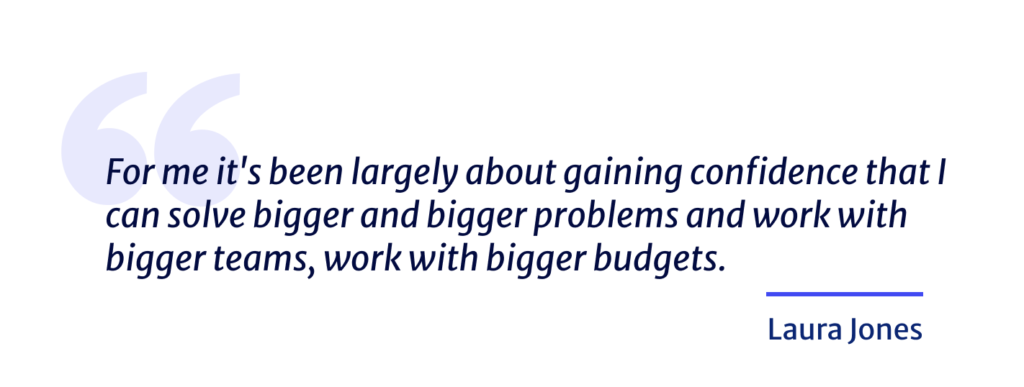
For me it’s been largely about gaining confidence that I can solve bigger and bigger problems and work with bigger teams, work with bigger budgets. It really has been this iterative approach of applying that framework, seeing where it works, seeing what it does, and then building confidence that no matter how big the problem, if you have a structured way to approach it, you’ll eventually get to a great solution.
“And the game keeps getting bigger. I also want to learn more about how do you upscale and make sure that you get time for yourself?”
That is a big and hard question. And I would say that’s something that even at this stage in my career, maybe, especially at this stage in my career, I am very much actively grappling with. Because I think that it is so important to have a constant learning mindset. To me, it’s a lot about creating the conditions for learning. Meaning, giving yourself that on-the-job challenge component that motivates you to actually learn and then having the resources to do it.
Because I’ve definitely fallen into the trap of like, let me buy a book about X, Y, Z skill, or let me like go take a class, and not necessarily having the motivation to fully engage or internalize it. I felt this way largely about some of the channel performance marketing piece where I had wanted to learn about it, I’d learned a bit about it.
But it really has to taken at various stages going deep into a channel and really having that on-the-job need to learn something that then has motivated me to say, okay, now I am gonna go take that class. Now I am gonna read the book.
So I think it’s that combination of the intent, but also, for me at least, a little bit of the forcing factor of like, okay, I really need to deliver. I actually really admire people who have the discipline to acquire the skill before it’s needed in that moment. But for me, that just-in-time approach has been really powerful and has enabled me to really diversify my skillset over time.
“There is something about feeling that pain, or that itch, that forces someone to then go out there and figure it out. There might be others that can plan ahead. But lifelong learning is that magical piece where you don’t need to know the answer today, but it’s important to know there are options. And I’ve made the mistake of buying books that look great on my bookshelf.”
Yes, beautiful books. And I do really think that it’s about having the confidence to take the challenge and raise your hand and say, I will do this thing. And even if I don’t know about it, I am confident I can learn that skill.
That was a big unblock for me, of realizing that it was okay to sign up for something that I wasn’t already a total expert in, knowing I could then learn those skills. That is a big unblock in a career to realize that you don’t have to know everything. You don’t have to have all the answers. You just have to have the will to acquire those skills and to get those answers. Again, through a learning process, and have that confidence that you can do that and you can get smarter and get better.
You might also be interested in: Everything Product Managers Need to Know about Hackathons
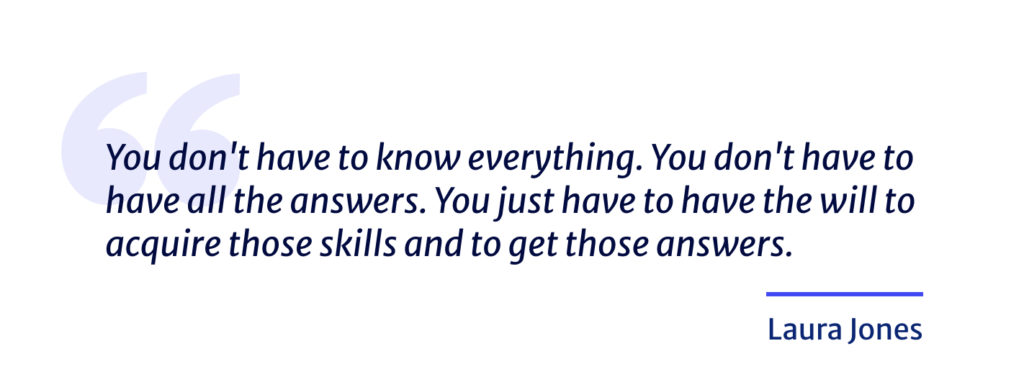
“Laura, as your team grows and you empower more leaders to make their own decisions. Is there anything in particular that you still like to do yourself that I know it scales, but it’s so core to your values that you want to be present there?”
I like to say, only do what only you can do. That’s advice I’ve given to many people.
Earlier we talked about those strategic deep dives. I do really like to spend time with teams understanding their strategy in detail and really understanding how they’ve set goals, why they’ve set those goals, what strategic frameworks they’ve applied to get to the kind of plan that they’ve developed.
That aspect of going deep on strategy and really understanding the why behind what a team is doing is great because then it enables me to say great, we’re aligned on the strategy. We have great talent and know that the execution is going to be impactful and effective.
That’s one place that I tend to go deep, and really wanna make sure I personally understand and I can speak. So that if I get a question I can speak to it intelligently.
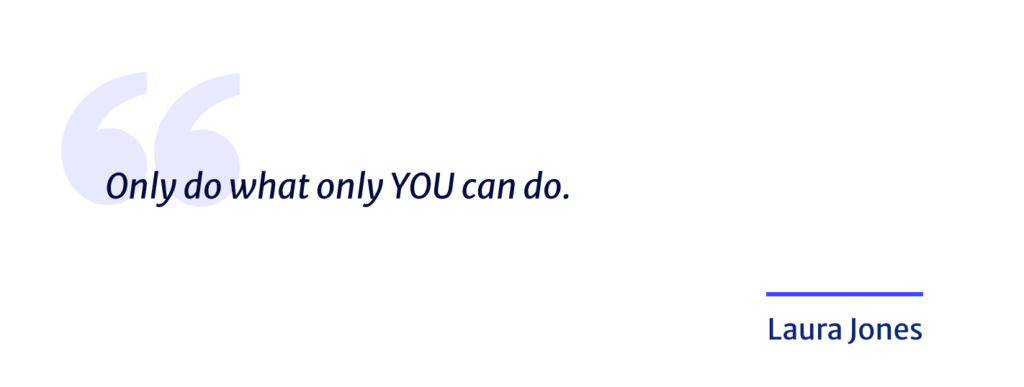
And then the other piece for me is on the creative and visual side. And this is maybe more of the brand part of the discipline and more of the art, but I think it is important for a brand. And when I say brand, I mean both the marketing and the product to have a cohesive look-tone-and-feel. And so I do think it’s important to have a consistent set of eyes across the most visible touchpoints.
So I really value creative review. I try to spend a lot of time with our creative team and also with our product design team to make sure that when we’re putting out our product and our story into the world, it really feels like it has come from a cohesive and thoughtful perspective. That everything looks and feels like the Instacart brand that we wanna be.
I really value the ability to look at every asset. And not wanting to go too deep into the channel stack. And of course, there’s a lot that’s iterative. But anytime we’re doing something net new that is gonna have a high level of impressions, I really wanna look at it and have a discussion with the creative team to make sure that we feel it’s the best that we can produce.
“I personally find that so hard. I come from a technical background, and it gets to a point where as the higher you grow in your career, the less time you have to spend on every single person on the team. And obviously there are going to be engineers and designers and marketers who have their own opinions who spend more time on it, who are technically better at certain areas. How do you balance your own point of view and experience with creating space for other people to co-create with you?”
I think it’s something I’ve learned as I’ve scaled as a leader. Because again, I can track it in my career a time when I was managing a team of four to then a team of 10 to then a team of 20, then it was 50, then it was 70 and now it’s 120.
I have gone on that journey of learning how to scale myself, and how to empower and grow people. Because the thing is, as a leader of a team, the most important quality is that people trust and desire you to be their leader, right? If you are not a good leader, if you’re not helping people feel empowered and feeling masters of their craft, you are going to lose them. And so I think that aspect of really figuring out how to empower people to be the best at their craft has been something that I have very much tried to intentionally focus on.
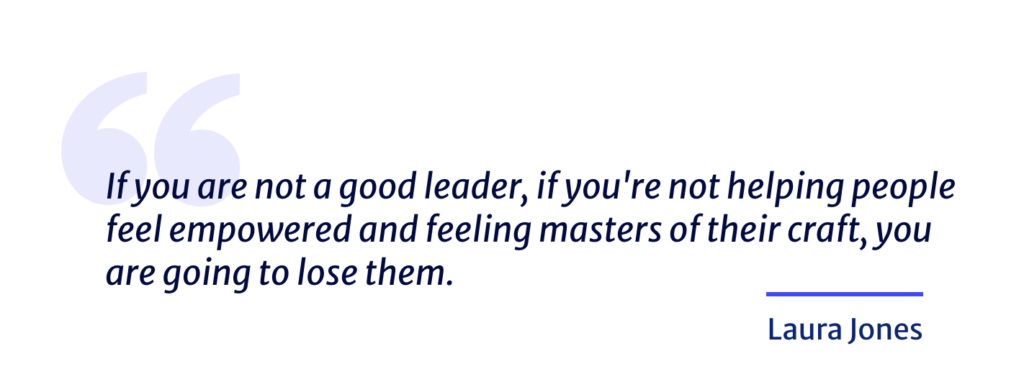
Another great read: How to Be a Better Product Leader in 2022
Practically, how do I do it? I think best practice is to really come in with a curious mindset, understand why somebody—whether it’s creative or an experimentation framework—understanding what was the intent, what was the thesis behind the work, or the impetus. And just taking a questioning and learning mindset so that everyone can be the master of their domain.
But also that there is that constant bar raising of making sure that we’re all approaching decisions in a really principled way. This is even more important for creative, because it can be so subjective. So that’s where having things like brand guidelines or having shared design principles become very important. Because it moves it a little bit out of the realm of purely subjective (I like orange versus green), to a world of, Hey, this is what we’re trying to accomplish. This is how we wanna show up in the world. And is this meeting those bars? And if yes, then it really should be that domain expertise decision, the exact shade of green it is. Because we’re all aligned on the principles and how we got to where we are.
“I like your approach to hiring people. You personally helped me. And I would like to dig a little deeper into that so more people can benefit from it. So now that you’re in a position where you can really empower existing leaders and help them grow as well as bringing new talent, what is your framework to assess talent?”
Oh, I love this question because I feel like it’s something I’ve obsessed over. And especially at Uber where over six years, we built this team to a peak of 65 on the product marketing front, all through organic growth. Because of the time and in the journey that we were at, it was all hand-hired by the team.
It was a time when we needed to scale hiring but we wanted to keep a really high bar. So we thought deeply. And basically what, the way I would summarize it is evidence-based hiring. I really overvalue work product that I can observe and assess and evaluate kind of independent of a candidate profile. Because to me it’s so indicative of what this person will be producing.
I tend to personally place a little bit less emphasis on a behavioral interview. While I still value and wanna get to know people, I’m so much more interested in, when we give someone a prompt or piece of homework and give them the time and space to approach it, what do they come back with?
Read next: How to Attract, Hire, and Grow Diverse Product Teams by Disney Head of Product
And by the way, we look at portfolios not just for creatives, but for all of our strategy roles as well. So brand, product marketing, et cetera. We have people present case studies speaking to both the brief as well as the creative output and impact. And I find that combination of kind of either live jams or written homework where there’s a specific problem focus, and we can observe the work process and product.
And then this kind of speaking to past work, and speaking to why decisions were made. Owning successes, owning failures, owning learnings. For me, that’s been, that’s been really, really critical.
Because again, there’s so much risk for bias. If you’re just scanning a LinkedIn profile, what school did this person go to? What company did they work at? Somebody might be a really great interviewer, but they might not be really like down to do the work. And that’s where I think again, this evidence-based mode is helpful to level the playing field and really see what people are made of.
“Especially in roles related to marketing, sales, where people are trained to be good presenters. And there was this misconception that only engineers and designers can actually show stuff. But we can see marketers, product people build and guide you through a thought process and also prove that they’re not only good communicators. They can also be good builders.”
Yeah, exactly.
“I like to wrap up my interviews with a question related to your younger self. If you were to give advice to your younger self to get to where you are a little bit, what would you have done differently?”
It goes back to that earlier conversation around how raising your hand to try new things, and being confident that you can learn new skills. Even learning those skills on the job.
There’s so many disciplines and subdisciplines in the world of marketing and the world of product. And it’s, it’s easy to say, oh, I’m good at this thing, I’m just gonna keep doing it. And what I wish I would’ve done earlier, and would encourage others to do, is to just say, Yeah, maybe I’ve mastered the discipline of product marketing. Maybe now I will go try growth marketing, or brand marketing, or product.
At Uber I had probably five or six PMMS who went on to become PMs. In some cases they were really excellent PMs because they really understood how to drive adoption and how to really root work in customer insights.
So I think just not being afraid to take a risk, learn something new, even if you’re not gonna be perfect at it on day one, just knowing that you are a learning organism. That you are somebody that can go out and feel confident taking things on. I think that’s the thing that will differentiate people who have a faster or slower career trajectory. So confidence and lifelong learning would be the takeaways I would wanna offer to myself and to anyone else.
Listen to our episodes on your favorite platform
Stay tuned for new episodes
By sharing your email, you agree to our Privacy Policy and Terms of Service



